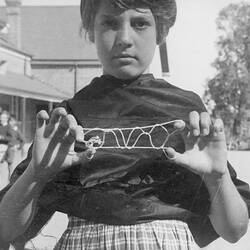Summary
Alternative Name(s): Doll - Netherlands National
Donated to the Australian Children's Folklore Collection by the Royal Netherlands Embassy in 1990.
National doll which forms part of the Australian Children's Folklore Collection (ACFC).
The ACFC is unique in Australia, documenting contemporary children's folklore across Australia and in other countries reaching back to the 1870s. The Collection has a strong component of research material relating to Victoria.
Dolls are among the most universal toys found throughout the world and through history. They can be as simple as a stick or piece of wood or as elaborate as a mechanical walking and talking doll. Children use dolls in role-playing where they learn and practise socialisation skills and adult responsibilities; they use dolls to play parts in imaginative games; they use dolls as 'comfort toys'; and they exercise their creativity in making their own dolls from materials found around the home. Ornamental dolls can also be used to represent aspects of cultural traditions, such as dress. This is a contemporary doll wearing traditional costume from the Friesland region of the Netherlands.
Physical Description
Modern female doll dressed in traditional costume from the Friesland region of the Netherlands. The doll has short dark hair covered by a white lace cap which comes down to her shoulders. The cap has gold hair clips on either side. She has a double string of black beads around her neck. The dress is black with a floral pattern in orange, red, green and blue. She has a narrow white lace shawl around her shoulders and a white lace apron around her waist. A black velvet bag is pinned to her waist. Also pinned to her waist are a pair of scissors, a piping nozzle used in cake decorating and a tiny silver container. These possibly represent traditional women's trade skills. She is wearing black shoes with gold buckles and cream stockings. The doll is mounted on a wooden display board and contained in a yellow cardboard box with a clear plastic front. The body is made from moulded plastic and the eyes close when the doll reclines. Acknowledgement: Australian Children's Folklore Collection, Museum Victoria.
More Information
-
Collection Names
-
Collecting Areas
Home & Community, Clothing & Textiles, Childhood, Migration & Cultural Diversity
-
Acquisition Information
Cultural Gifts Donation from Dr June Factor, 18 May 1999
-
Acknowledgement
Donated through the Australian Government's Cultural Gifts Program.
-
Place & Date Made
-
Classification
-
Category
-
Discipline
-
Type of item
-
overall dimensions
11.5 cm (Length), 11.5 cm (Width), 34 cm (Height)
-
Keywords
Children's Folklore, Cultural Identity, Dolls, Netherlands, Souvenirs, Traditional Costumes, Making History - Australian Childrens Folklore
